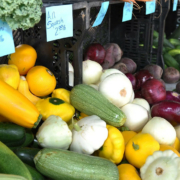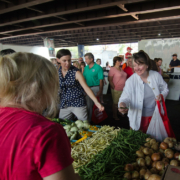Farmers Market Pricing Strategies for Vendors
 Print This Post
Print This Post
By Tammy Howard, NCAT Agriculture Specialist
Farmers markets continue to be a low-risk marketing strategy for beginning farmers. However, vendors often struggle to figure out the right pricing strategy. Many beginning farmers start out with a pricing strategy that reflects what everyone else is charging. While this is a good place to begin, it is not where you want to be forever. It is important to know your costs and set prices for profit and for the customer that you are selling to. In this blog post, I will touch on a few different strategies and then talk about the strategy that might be best for vendors selling at a farmers market. This is part of an effort to continue to expand capacity-building tools for market managers and vendors through the Montana Farmers Market Network website.
Regardless of your pricing strategy, start with calculating your production costs. This includes understanding your fixed and variable costs, and giving some thought to what you want to set aside for profit. A cash-flow worksheet will help you understand your costs of production of a specific enterprise. If you haven’t done a cash-flow exercise, I highly suggest you do this to understand how much it costs to produce your product over the course of the year. For example, if farmers markers are your only revenue stream (income), then the lack of revenue must be accounted for in the off-season or made up through an off-farm job or another source of revenue. A lot of beginning farmers struggle with figuring out variable and fixed costs without any past records. However, these costs can be estimated by researching online or visiting farm supply stores, or by talking with other farmers who are willing to share. For more information on cash flow and other essential financial documents, see the ATTRA publication Basic Accounting: Guidance for Beginners.
Once you have an understanding of your production costs, it is time to start exploring pricing strategies. I will discuss a few strategies that I have shared with farmers market vendors I work with. Cost-based pricing takes into account your production costs and a particular margin that you are striving for; however, it does not take into account what the customer is willing to pay. This pricing approach might be better if you are selling through a wholesale channel that doesn’t account for your brand or other ways you might add value to your product. The other piece in this pricing method is a fixed profit or margin that you add to your costs. Think about what that margin is per product. You can think of it in terms of a percentage; for example, it is not uncommon for a grocery store to mark up a product 40-70%.
Values-based pricing includes factors such as your farm brand, trust, customer loyalty, and practices that appeal to a specific clientele. This customer-based approach focuses on how YOUR customer values your product. With this method, consider what your customer values over your competition. Are you organic? Do you have the best flavored cherry jam? Is your meat entirely grassfed beef? What is the value that your customers attach to your product?
Marketing is an integral part of a values-based pricing strategy. Direct markets, like farmers markets, can give you a lot of flexibility with your pricing. There are more opportunities to get a higher price and a larger share of the consumer’s dollar by emphasizing the perceived value of your product to your customer, in addition to the actual value of your product. This is less possible in a wholesale situation, unless you have certifications that incur a price premium, such as organic certification or certified humane.
Another important consideration with selling at a farmers market is the costs associated with selling through this marketing channel. Setting up a market stall and staffing takes more time than making a call and delivering to a wholesale account. A great resource for exploring these considerations is Tips for Selling at Farmers Markets. It is also important to understand the prices of your competitors and make sure that yours are within reason, or that customers have a willingness to pay for the difference in your product. Customers have shown a willingness to pay a premium for things like selection, convenience, quality, service, seasonality, and supporting local farms. When pricing to match your consumers desires, we like to ask, “how can your product turn your customers pains into gains?” That is where a value-based strategy can be effective.
I was listening to a presentation by Paul Greive, CEO of Pasturebird, on the Barn2Door marketing platform. He has some seasoned and insightful tips for pricing:
- Simplify your pricing – You aren’t trying to make pennies to the dollar in a direct market! Think in terms of flat rates, such as bunches and baskets versus by the pound. This can help reduce operating costs at a farmers market, as well, because many states will require a certified scale.
- If possible, cooperate with other producers to add value to your product. For example, if you sell lamb, work with herb producers to sell it with fresh rosemary as a package.
- Talk to your customers to find out a fair price for your product.
- Find the gaps at your market. For example, Tumbling Shoals Farm in North Carolina bought a roaster to sell roasted red peppers at their farmers market—significantly adding to the asking price of their peppers with little more cost than this equipment investment.
For more tips from Paul Greive, listen to the archived webinar Pricing your Products for Profit and Ease.
Pricing can seem overwhelming to a beginning farmer selling at farmers markets, but if you work to understand your production costs, your customer, and how your product provides value to that customer, you will be well on your way to a values-based pricing strategy. The Montana Farmers Market Network website contains many tools to help vendors be successful at selling at farmers markets.
Related ATTRA Resources:
Basic Accounting: Guidance for Beginners
Other Resources:
Montana Farmers Market Network
Farm Innovator Series: Pricing Your Products for Profit and Ease
This blog is produced by the National Center for Appropriate Technology through the ATTRA Sustainable Agriculture program, under a cooperative agreement with USDA Rural Development. ATTRA.NCAT.ORG.



 USDA photo by Lance Cheung
USDA photo by Lance Cheung USDA photo by Ed Ragland.
USDA photo by Ed Ragland. USDA Photo by Lance Cheung.
USDA Photo by Lance Cheung. 





